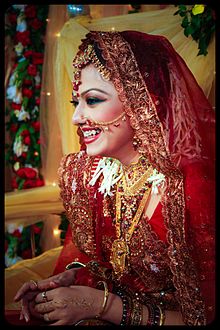Bengali Muslim wedding
| Part of a series on |
| Bengalis |
|---|
 |
A Bengali Muslim wedding (Bengali: বাঙালি মুসলিম বিয়ে) is a Bengali wedding in accordance with the Muslim faith. It includes rituals and ceremonies that may span up to three days. In most cases, it starts with the Dekha Dekhi (promising of marriage), followed by the nikah (Muslim marriage registration), which is conducted by a Qazi with a fixed denmohor (payable to the wife). It ends with the Bou Bhat ceremony, which is popular as the wedding reception arranged by the groom's family.[1] This is the dominant tradition of weddings seen among the Bengali Muslims of Bangladesh and the West Bengal state of India.
Wedding arrangement
[edit]Like many non-industrial societies,[2] Bangladeshi culture views marriage as a union between two families rather than just two individuals.[3] In Bangladesh, arranged marriages are arguably the most common form of marriage[4] and are considered traditional in society.[5]
A cultural wedding is arranged by a ghotok (matchmaker), who is generally a friend or a relative of the bride and groom's parents. Ghotoks facilitate the introduction of the bride and groom's identities to their respective parents. Families traditionally seek matches for the bride and groom from the same religion and good social standing, and never allow unemployed men to become grooms. In the case of an arranged marriage, if the aforementioned compatibility factors are duly matched, only then is the pairing deemed an ideal match. Apart from arranged marriages, there are also love marriages and semi-arranged marriages, which are based more on the preferences and wishes of the partners than strict traditional norms. Though love marriages are forbidden by most families, the restrictions are loosening day by day,[6] and inter-gender friendship is frowned upon by society.[5][7][8]
Once the arrangement is made, the planning of the wedding itself is done by the parents. They usually start planning the wedding venue several months in advance, or in some cases, just a few weeks ahead.[3][9]
Pre-wedding rituals
[edit]Paan Chini
[edit]Paan chini or chini paan is a tradition where two betel leaves and areca nuts are given to guests at any auspicious occasion. The name derives from these servings. Paan (betel leaf) served with silver foil signals festivity, and during such propitious occasions, it is also common to bring sweets. These gestures symbolise friendship and a heartening promise.[3]
Turmeric ceremony
[edit]
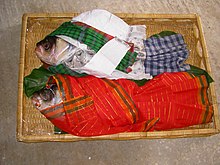
This ritual is followed by turmeric ceremonies or Gaye Holud (Bengali: গায়ে হলুদ lit, "Turmeric in the body") that take place before the wedding ceremony.[10] There is one turmeric ceremony for the bride and another for the groom. For the bride's Gaye Holud, the groom's family - except the groom himself - travel in procession to the bride's home. They carry the bride's wedding dress/outfit, some wedding decorations including turmeric paste (that has lightly touched the groom's body), candy/sweetmeats, and gifts. They also bring a large Hilsha or Rohu fish decorated as a bride. After the two "yellowing ceremonies", the bride and groom are bathed in the water that the women had fetched from the waterway early that morning. There are local variations on this tradition, such as providing a specific number of fish to the party responsible for cooking them, and determining the best time to deliver the fresh fish to the groom's family.[10]
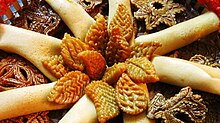

The turmeric paste is applied to the bride's skin by her friends. This is said to soften the skin, but it also colours her in the distinctive yellow hue that gives its name to this ceremony. The sweets are then fed to the bride by all involved, one at a time. Following this, a feast for the guests is served. Married women present may also stain each other with turmeric paste. Brides also adorn their hands, arms, and feet with Alta (dye) or Henna (also known as Mehendi) on this day.[11] Meyeli Git (Female Song), folk songs sung by rural women individually or collectively at family gatherings and social ceremonies, are performed during different marriage rituals such as the Gaye Holud ceremony, the bride and bridegroom bathing ceremony, while the bride is being dressed, the welcome and farewell to the bridegroom, and the farewell to the bride.[12]
Wedding ceremony
[edit]
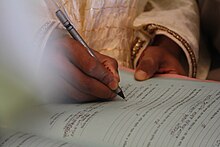
Bou Bhat
[edit]
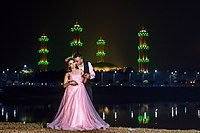
Changes
[edit]In the past, weddings would take place in the bride's home as community centers were not available. Many people would be invited to the wedding. In the villages, women would sing geet, a traditional type of song sung at weddings, and dance. Nowadays, modern music has taken over the geet, and most weddings are held at community centers.[3] Some weddings are now organised as joint programs where the biye and bou bhat are arranged together and jointly sponsored by the parents of both the bride and groom.
Chittagongian wedding
[edit]The Chittagong region has some unique traditions compared to the Bengali traditions of other divisions in Bangladesh. One of the unique wedding rituals of Chittagong is Boujorni (Bengali: বউজড়নী) or Jora Gantha (Bengali: জোড়া গাঁথা). Another event in Chittagong's Bengali culture, which takes place the night before the bride arrives at her in-laws' house after the marriage, is called Pansholla (Bengali: পানশল্লা). This event is observed by both Muslims and Buddhists in the area. Similar to how the groom, along with his friends and family, traditionally arrives later in the evening in a procession called Borjatri, in Chittagongian society, there's a similar tradition for the bride's side, known as Soari (Sawari) (Bengali: সোয়ারী). The word "Sawar" means "ride" and is used among South Asian communities. It is believed that because the bride used to ride on a Palki, it is called Soari/Sawari. The Borjatri is known as Boirati (Bengali: বৈরাতী). The people from the Boirati are served Duruch Polao (Bengali: দুরুচ পোলাও), which is a type of Bengali pilaf originating in Chittagong. The Duruch is made by marinating a whole chicken with Bengali spices, then slightly burning it directly on a flame, and frying it in oil. Another dish, called Nunnuch (Bengali: নুন্নুচ), is a type of curry.
Gallery
[edit]-
Wedding celebration
-
A traditional Bengali bride on her Gaye Holud
-
Groom and bride
-
Bride with family members and relatives
-
Groom is praying according to Muslim marriage rituals
-
Traditional bride
-
Bride's hand with a large ring
-
Bangladeshi newly married couple
-
Wedding celebration in Dhaka
-
Fun in Gaye Holud
-
Bride is ready for ceremony
-
A Bengali Muslim groom in traditional Sherwani
See also
[edit]References
[edit]- ^ "Marriage, family and tradition in Bangladesh". vsointernational.org.
- ^ Kottak, Conrad Phillip (2010) [First published 1996]. Mirror for Humanity: A Concise Introduction to Cultural Anthropology (7th ed.). McGraw-Hill. p. 157. ISBN 978-0-07-353104-5.
- ^ a b c d Khan, Maheen (11 November 2014). "A Bangladeshi Wedding Journal". The Daily Star. Retrieved 17 January 2020.
- ^ "83pc had arranged marriages" (PDF). Research of Kent, Malaya, Brac Universities. 2015.
- ^ a b "6 Places In The World Where Arranged Marriages Is Traditional & Historically Practiced". Elite Daily. 5 February 2019.
- ^ "To Love In Bangladesh". HuffPost. 19 May 2014. Retrieved 14 November 2024.
- ^ "Love, elopement, and all that". Dhaka Tribune (Opinion). 12 February 2018. Retrieved 29 July 2018.
- ^ "Bangladesh-Culture: Marriage is a Family Decision". Inter Press Service. 12 January 1997.
- ^ "The changing nature of wedding ceremonies". The Financial Express. 26 December 2019.
- ^ a b "A bright roaring with glitter wedding party". Travelife.
- ^ দাও গায়ে হলুদ, পায়ে আলতা. e-barta247.com (in Bengali).
- ^ "Meyeli Git". Banglapedia.

